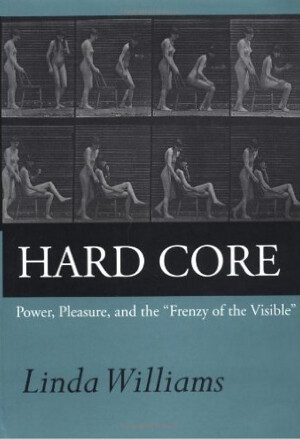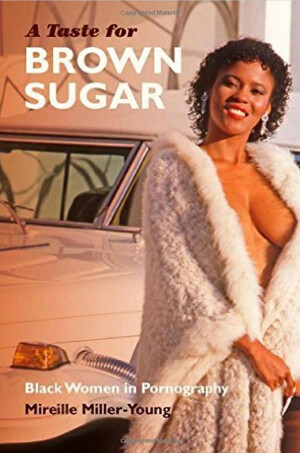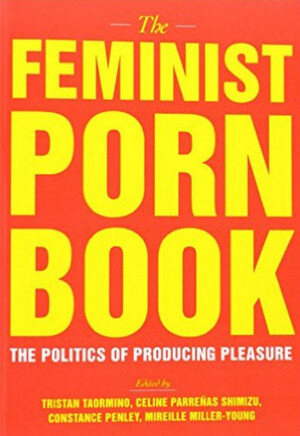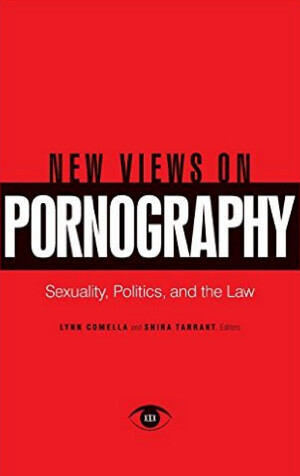
In 1980, while the major Hollywood studios were in the middle of
an unsuccessful lawsuit to enjoin owners of home videocassette recorders from
taping copyrighted material off-air, an estimated 60 per cent of U.S. video
sales were for pornographic films. By
1984, the U.S. Supreme Court had ruled against the majors, and an
already-existing infrastructure of video rental outlets, blank tape sales, and
exponential sales growth of VCRs convinced Hollywood that the new landscape of
home video could be profitably exploited. During this intervening four-year
period, porn filmmakers, distributors, and devotees negotiated the new
home-viewing context of pornographic feature films. Café Flesh (1982), produced and directed by
writer/director Steve Sayadian and cinematographer Frances Delia (under their
respective noms de porn,
“Rinse Dream” and “F. X. Pope”) was released by porn video “major” VCA Pictures
to massive critical acclaim and record sales. The film is set in a post-nuclear
fallout future where the vast majority of people are incapable of having sex
and the remaining minority are required by law to perform in live sex shows for
the entertainment of the “sex negatives.”
Initial publicity surrounding the film’s
theatrical release contrasted its high production values, literate script,
extraordinary musical score, and seemingly bottomless contempt for the porn
viewing audience to the production context, aesthetic values, and commercial
viability of mainstream porn. Café
Flesh was received as a movie
that was “not really” porn, made by industry outsiders, and which had sailed
way over the heads of mainstream porn audiences, who were actually visible
onscreen as drooling, slack-jawed, resentful zombies, many with open sores and
physical disabilities.
Central to both films’ wild generic hybridization and downbeat themes is screenwriter Herbert W. Day who, as Jerry Stahl, wrote scripts for some of the most successful television programs of the eighties and nineties, including Moonlighting, Alf, Northern Exposure, and Twin Peaks, and whose struggle with drug addiction was chronicled in the memoir Permanent Midnight. Although Stahl has never acknowledged this, Café Flesh is based on the premise of cult sci-fi novelist Tom DeHaven’s Freaks Amour, published by William Morrow in 1979, which told a strikingly similar post-nuclear mutation / sex cabaret story.
The central conflict in Café Flesh turns on heterosexual couple Lana and Nick. Lana is played by future “scream
queen” Michelle Bauer, acting under her porn pseudonym “Pia Snow.” Lana and Nick have been a couple since
before the nuclear holocaust, and Lana is struggling to keep her continuing
sexual desire and functioning a secret from Nick and the authorities, who would
force her into a life of performing if her positive status were revealed. We see this in a subplot in which the
virginal teenage runaway Angel, played by porn supporting player Marie Sharp,
is literally sniffed out as a positive by enforcement bounty hunters,
kidnapped, and returned to Café Flesh to perform her debut number as a
despairing Nick and increasingly aroused Lana are forced (or at least
compelled) to watch.
In a role based on Joel Grey’s from Cabaret, the Café’s
misanthropic master of ceremonies, Max Melodramatic (played by Andrew Nichols
in one of the greatest performance ever in a hardcore movie), takes pleasure in
taunting the negatives from the stage and begins a particularly vicious campaign
against Nick after he secretly witnesses Lana masturbating after hours at the
club. His goading of Nick
is phrased in terms which explicitly link virtuosity of performance in showbiz
with basic sexual functioning: “Listen,
pal. Before the nukes I was
a two bit yuck hustler bombing in the Borscht Belt. For ten years, fuckin’ squares like
you kept me on the bottom. But
I’m on top, buddy boy, and don’t you ever forget it. Now it’s time for me stare into your
face and laugh.” We learn
that Max is neither positive nor negative. Rather, he is a eunuch, having lost
his genitals in the nuclear conflagration.
The two leads of the film, Michelle Bauer and Paul
McGibboney, turn in performances wholly consonant with Hollywood’s norms of
acting professionalism. The
muscular but impotent Nick oozes despair and pessimism and reads his lines in
an dead, emotionally shattered tone reminiscent of male voice-overs from films noirs of the forties. Lana’s is the film’s most complex
performance, her character evincing an increasingly frantic attempt to perform
the role of sex negative as the desires aroused by the cabaret performances
begin to overwhelm her.
The cabaret is abuzz with excitement that the most
famous performer on the sex circuit, the massively hung and insatiable Johnny
Rico, played by Sayadian’s favorite B-list porn stud, Kevin Jay, is coming to
perform at the club. Watching
Johnny Rico coldly topping a female performer onstage, Lana can no longer hold
back, and she walks to the stage in a slow motion trance and unleashes her
desire with Johnny Rico as Max laughs in the face of a completely broken
Nick. But at the moment,
“Lana” can no longer sustain the role of a sex negative within the narrative of Café Flesh, Michelle Bauer can
no longer sustain her role as porn actress Pia Snow, and porn actor Kevin Jay
performs with a body double in the emotional, thematic, and hydraulic climax of
the film.
Even the
film's earlier sex performance pieces display a jarring discontinuity of tone
and rhythm. Angel’s debut number at the cabaret, which features art
deco visual motifs and men wearing telephone masks and which takes place on top
of trapezoidal phone booth inside which a nude woman writhes and attempts to
escape, is choreographed with mechanical precision. Disembodied
hands emerge from the stage floor and snap fingers in time with the score, and
her two male partners move her up and down the surface of the overturned phone
booth in time to the music. But when Angel / Marie Sharp begins her
explicit sexual performance, both the rhythm of the bodies and the rhythm of
the editing lose the beat, and the undulating pattern of body movement become
the driving force of the cutting. After we see this virtuosic
display of pornographic performers in action, Angel exits the stage and
excitedly greets Lana and Nick, and the line readings of Marie Sharp are as
unconvincing as Michelle Bauer / Pia Snow / Lana’s body double is to hawk-eyed
fans yearning to see their favorite scream queen fucking before she became
famous.
Café
Flesh pushes almost to the breaking point the clashes between the
different registers of performance and film style characteristic of the porn
feature aiming to approximate the understated virtuosity of even off-Hollywood
cinema, but many films in this period attempted to combine the norms of
hardcore and general release cinema. Several changes in the porn
film industry worked to provide commercial incentives to produce ambitious and
innovative films in search of a box-office hit. After revisions to the Tax Code
eliminated the tax shelters for motion picture investment in 1976, the number
of annual features declined steadily 1983. As the number of films
declined, budgets began to rise, and high-profile star vehicles such as Miracle
Films' Marilyn Chambers feature Insatiable (1980), Evart
Enterprises' Deep Inside Annie Sprinkle (1981), the Veronica
Hart caper comedy Wanda Whips Wall Street and the Annette
Haven costume romance 1001 Erotic Nights (both 1982) became
huge hits on the adult circuit, which saw large numbers of 16mm houses replaced
by 35mm theaters as failing subsequent run houses converted to
porn. In distribution, the states rights system, with its single
payment up front by a sub-distributor in exchange for regional distribution
rights, was replaced by studios booking directly into theaters along with an
orderly clearance system in which films were distributed in zones radiating out
from major markets, with large numbers of prints circulating through the
market.
Paul Thomas Anderson’s Boogie
Nights mythologizes the
coming of video to the porn industry in much the same way that MGM’s Singin' in the Rain mythologized the coming of sound to
Hollywood: At a New Year’s
Eve celebration in the final hours of 1979, a video executive shows up at the
house of a porn director and announces that he represents the future. Like Singin'
in the Rain, this makes for better storytelling than history. Porn’s transition to video production
was measured and took place against the background of an industry committed to
producing films with high production values for theatrical release. The Sony Betamax was introduced in
1975 as a high-end consumer item and was considered too expensive to serve a
conduit to a large porn-consuming public. Further, the VHS / Beta format wars
caused a lack of standardization and a doubling of lab fees for video
transfer. During the
earliest years of home video, the porn industry exploited video by releasing
its back catalog to the home format and replacing Super 8mm in arcades and peep
shows with the Sony Betamax. The
original video productions did not appear until 1983.
The company which released Café Flesh to theater and home video was VCA
Pictures, whose full company name was VCA Labs, Inc., originally a tape duplicating
service which provided mass-produced copies of videocassettes to several porn
companies. VCA was
established in 1980 and was promptly sued by the Veterinary Council of
America. After this initial
setback, the company acquired the rights to a small back catalog and released
its own titles beginning in 1981. Café
Flesh was the inaugural
release of its theatrical division in 1982, and its first 35mm production was New Wave Hookers in 1985, a spectacular box-office
success which influenced the next generation of porn filmmakers and became a
profitable franchise which exists to this day.
New
Wave Hookers’ director, Gregory Hyppolite aka Greg Dark of the “Dark Brothers,” was
the head of VCA’s theatrical division and oversaw the company’s buying of the
film from Harry Mohney and Caribbean, its promotion as a movie too good for
porn made by industry outsiders, and its careful multi-platform theatrical
release. Hyppolite was so
taken with the film’s visual style that he hired Café Flesh’s production
designer Paul Berthell, credited onscreen as “Pez D. Spencer,” to craft the
signature stylized look of the Dark Brothers’ films throughout the
mid-eighties.
The clashing registers of performance and
style in Café Flesh’s
visual design, linking scenes, and explicit sex are paralleled in the multiple
exhibition and reception contexts the film inhabited in 1982. The film was released in March of 1982
to hardcore circuits in major markets. Shortly
after this, VCA farmed out an R-rated cut to Fox Lorber for distribution in art
theaters in an effort to capitalize on that distributor’s previous success in
booking risqué art films into theaters in the Landmark chain. Also, VCA placed the film in several
midnight bookings in art theaters in a hardcore version with the cumshots
removed, seeking to raise its cultural leanings to level of say, Pink Flamingos by omitting the most déclassé and
downscale trope of the porn genre while preserving its “transgressive”
elements. This experiment
was not a success, but the film reaped moderate financial rewards as a
supporting feature and through block-booking arrangements. Steve Sayadian’s stories of “riots”
breaking out in hardcore houses where the film was shown appears to be an
overstatement. The movie
was released to home video just weeks afterward, before it had finished its
theatrical playoff in the outlying zones away from major markets. This was part of a series of “day and
date” experiments by the porn industry which coordinated the theatrical and
video releases of a high profile feature and which also included a 1981 New
York City booking of Ron Sullivan’s Babylon
Pink at which the film was
offered for sale in the lobby after the screening for the then-standard price
point of eighty dollars. Café
Flesh became one of VCA’s most successful video releases in both its hardcore
and softcore “cable” versions.
Café
Flesh provides a case study
of the changing porn industry’s attempt to expand both the demographic groups
to to which its products might appeal and the spaces in which this audience
could be reached. The story
of Café Flesh’s ultimate
success as a crossover film on home video points to a series of
seldom-questioned assumptions about the aesthetic tastes and rungs on the
cultural food chain inhabited by porn audiences on one hand and cult movie
aficionado “hipsters” on the other. Throughout
the period of porn’s theatrical distribution in the 1970s through the
mid-1980s, audiences responded very favorably to artistically ambitious,
challenging, and innovative films, making many of them huge box-office
hits. Later, a larger
crossover audience in home video was in fact parasitic on the cultural
discernment of the porn crowd, an audience which had rewarded filmmakers’
experimentation and which provided home-video distributors with pre-tested
commercial properties likely to benefit from a modified sales pitch to the smug
and contemptuous larger viewing public. This larger pubic often disingenuously viewed
themselves as cultural “pozzies” alive to the pleasures only dimly remembered
by the “neggies” who haunted x-rated exhibition circuits during porn’s greatest
artistic flowering.
Many thanks to adult film historian and preservationist Joe Rubin, who patiently explained the history of the distribution of film prints through the x-rated theatrical market in the late seventies and the industry's measured and multi-phase embrace of home video. Rubin and his colleagues at Vinegar Syndrome continue to do excellent work in the preservation and restoration of classic adult films and cult movies for DVD, and their online streaming service, ExploitationTV, offers full 1080p streaming of a range of XXX, horror, and international films from the Vinegar Syndrome catalog and elsewhere. Their work deserves our support.
Many thanks to adult film historian and preservationist Joe Rubin, who patiently explained the history of the distribution of film prints through the x-rated theatrical market in the late seventies and the industry's measured and multi-phase embrace of home video. Rubin and his colleagues at Vinegar Syndrome continue to do excellent work in the preservation and restoration of classic adult films and cult movies for DVD, and their online streaming service, ExploitationTV, offers full 1080p streaming of a range of XXX, horror, and international films from the Vinegar Syndrome catalog and elsewhere. Their work deserves our support.


The academic field of media studies has produced a diverse and incredibly well-researched body of work on the porn industry, its history, its products, its key players and some of the social implications of its enduring popularity and struggles with censorship. These titles feature some of what I consider the best writing from scholars in the U.S. and the U.K. on the topic. The Feminist Porn Book contains thoughtful essays by performers, media makers, and activists as well.




Coming soon: "Dumb White Guys Unite!
Or, `Hey Rush, Am I on the Air?'"









No comments:
Post a Comment